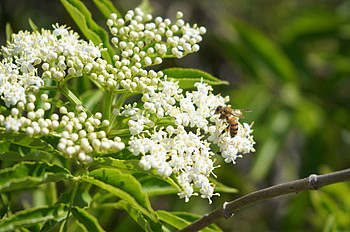Origin of the elderberry

The botanical name of the black elderberry is Sambucus nigra and it is native to Europe and Asia Minor. Its great popularity has given the plant many nicknames: In addition to Holler in southern Germany and Holder in Switzerland and Austria, elderberry is often called lilac bush or black lilac in northern Germany. An elder bush grows up to eleven metres high, is bushy and has many branches. The plant is robust, hardy and extremely undemanding in care. The intensely fragrant, umbel-shaped flowers, which appear from around May, are extremely popular with bees and other insects.
Over 20 different elderberry species
The black elderberry that we use for our juices has a total of almost 20 other related species: In total, there are over 20 different elderberry species worldwide. They all belong to the genus of muskweed. Three of them can also be found in Germany, viz.
- the black elder,
- the red elder and
- the dwarf elderberry
But beware: while black and red elderberry can be eaten cooked, dwarf elderberry is poisonous and not suitable for consumption.
Grow and harvest lilac berries
The elderberry is a good garden plant, it likes a sunny to semi-shady location with nutrient-rich, not too dry soil. Shortly after flowering, the first fruits form on the elder bush. Elderberries or lilac berries grow in umbels and take on a deep dark, black-red colour as they ripen. Harvest time for elderberries is around September and October, depending on the growing area. The easiest way is to cut off the entire panicle with a sharp knife and then carefully strip off the berries. Just like the berries, the flowers can also be harvested and used as a basis for food, for example as an ingredient for tea or elderflower syrup.
Ingredients of the elderberry and its flowers
Elderberries get their intense dark colour from the high content of anthocyanins, plant pigments from the flavonoid group. They are water-soluble and make elderberries, like wild blueberries and blackcurrants, an effective natural colouring agent. The flowers of the elderberry contain essential oils that are responsible for the bewitching scent.
Attention: Do not consume elderberries raw
The leaves, bark, unripe fruits and seeds of ripe elderberries contain sambunigrin. This is slightly poisonous for humans and many animals and can lead to indisposition, vomiting and other symptoms of poisoning. The relevant parts of the elderberry plant should therefore not be eaten raw. By heating, sambunigrin decomposes and is thus rendered harmless. When processing the elderberries into our Elderberry juice, the berries are heated accordingly so that the juice does not contain sambunigrin.
Processing black elderberry
Elderflowers can be made into a tasty syrup or aromatic elderflower jelly.
The elderberries can only be kept for a short time and should therefore be processed as quickly as possible. For example, they are suitable for preparation as:
- Jam
- Stewed fruit
- Jelly
- Elderberry nectar or juice
If you don't have fresh elderberries at hand, you can fall back on our high-quality "Elderberry" pure juice from first pressing. Since the selected berries are only pressed once during the production of the pure juice from first pressing, many valuable ingredients of the elderberry remain in the juice.
FAQ
Are black elderberries poisonous?
The leaves, bark, berries and seeds of ripe elderberries contain sambunigrin, which can cause indisposition, vomiting and diarrhoea in humans. Therefore, elderberries should not be eaten raw. However, by heating, the sambunigrin responsible for this is decomposed, so that black elderberries are no longer poisonous after heating.
What can elderflowers and elderberries be used for?
Elderflowers, for example, can be made into syrup or fried in batter. Elderberries taste good as jam, compote or juice - best in the form of a high-quality pure juice from first pressing.
Is elder a tree or a shrub?
The black elder is a shrub and is one of the most common shrub species in Central Europe.

